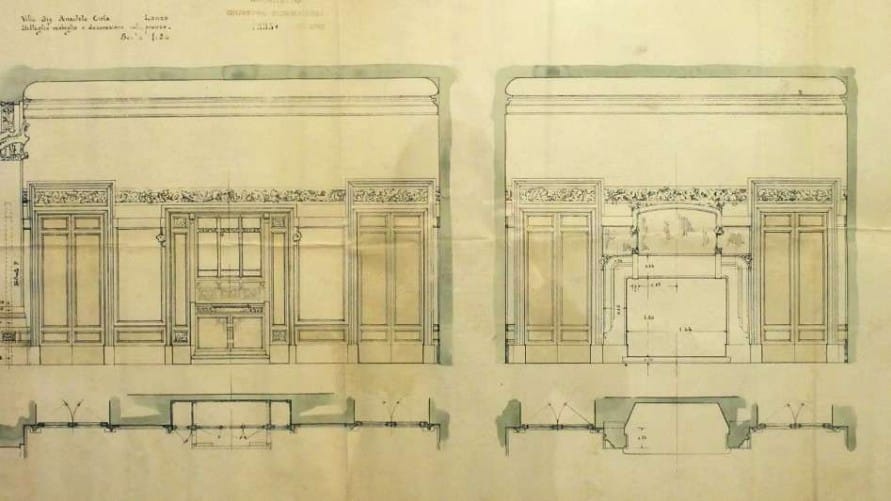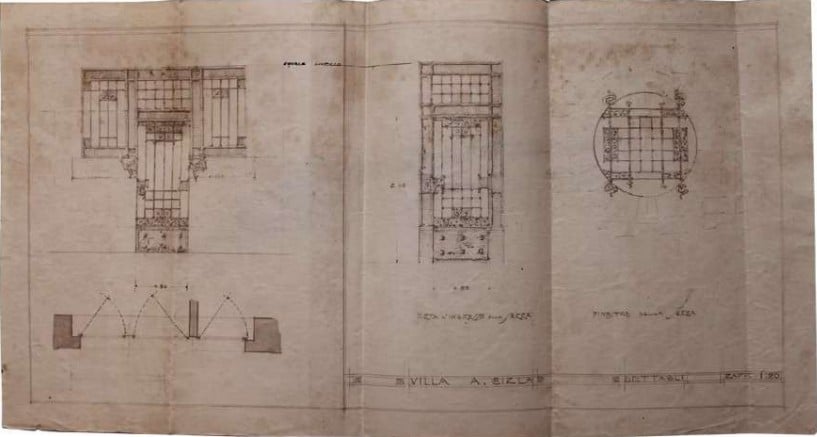- Giuseppe Sommaruga (1867–1917) Two-light wall lamp in bronze and glass
Wall-mounted applique made of bronze with two lights. A bronze panel designed with parallel lines intersecting vertically and horizontally, leaving solid and open spaces decorated with floral elements, serves as the support for the two lights. Each applique consists of an arm holding a square frame with Art Nouveau motifs, made of bronze with perforated sections through which a yellow fabric lampshade is visible. From this frame hang curtains made of glass rods that cover the bulbs.
Dimensions: 107.5 × 133 × 43.5 cm
PRODUCT CODE: ANILLA0292629
Giuseppe Sommaruga (Milan, 1867–1917) trained at the Brera Academy of Fine Arts under the guidance of Camillo Boito. He distinguished himself early on with his projects, starting in 1890 at the Turin Architecture Exhibition, where he was already working with the Cirla family on the design of a funerary monument.
His first real successes came in 1894 when, in addition to designing several pavilions for the exhibition at the Castello Sforzesco and Parco del Sempione, he received an honorable mention and a gold medal for his design of the Congress Palace for the Argentine Republic. This success brought him the recognition that enabled him to begin working for prominent Milanese private patrons, including the Marelli and Cirla families. His main work in Milan was Palazzo Castiglioni on Corso Venezia (1900–1903), designed in a Liberty style that eclectically incorporated Baroque elements and featured collaboration with Alessandro Mazzucotelli for the ironwork. From that point on, he became one of the most sought-after architects in Milan and the Varese area, where he was particularly active.

Giuseppe Sommaruga (Milan, 1867–1917) trained at the Brera Academy of Fine Arts under the guidance of Camillo Boito. He distinguished himself early on with his projects, starting in 1890 at the Turin Architecture Exhibition, where he was already working with the Cirla family on the design of a funerary monument.
His first real successes came in 1894 when, in addition to designing several pavilions for the exhibition at the Castello Sforzesco and Parco del Sempione, he received an honorable mention and a gold medal for his design of the Congress Palace for the Argentine Republic. This success brought him the recognition that enabled him to begin working for prominent Milanese private patrons, including the Marelli and Cirla families. His main work in Milan was Palazzo Castiglioni on Corso Venezia (1900–1903), designed in a Liberty style that eclectically incorporated Baroque elements and featured collaboration with Alessandro Mazzucotelli for the ironwork. From that point on, he became one of the most sought-after architects in Milan and the Varese area, where he was particularly active.

Denise Ledoux-Lebar, Les Ébénistes du XIXe Siècle, Paris, Éditions de l’Amateur, 1984, pp. 48-50;
Christopher Payne, Mobili di Parigi: il mercato di lusso del XIX secolo, Château de Saint-Rémy, Éditions Monelle Hayot, 2018, pp. 253-256.
Mariacher G., Lampade e lampadari in Italia, Dal Quattrocento all’Ottocento, Milano, Garzanti Editore s.p.a., 1981, p. 117.

FineArt is the new ambitious Di Mano in Mano project that offers an exclusive choice of antiques and design works, presenting them for their singularity and uniqueness.

FineArt by Di Mano in Mano is a team of experts at your service to enhance furniture, paintings, finest antiques, art and design masterpieces at best.
Di Mano in Mano
Via Castellazzo 8, Cambiago (MI)
20040